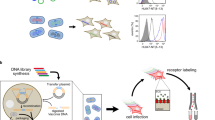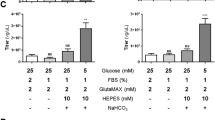Abstract
We have engineered mammalian cell lines to produce high levels of heterologous proteins by constructing a cell line that expresses the herpesvirus transactivator, VP16. Subsequent stable transfection with a gene of interest under control of a herpesvirus immediate early promoter led to a rapid isolation of cell lines producing between 1 and 20 micrograms of protein/million cells/24 hours. This high level expression is stable for at least five months.
This is a preview of subscription content, access via your institution
Access options
Subscribe to this journal
Receive 12 print issues and online access
$209.00 per year
only $17.42 per issue
Buy this article
- Purchase on Springer Link
- Instant access to full article PDF
Prices may be subject to local taxes which are calculated during checkout
Similar content being viewed by others
References
Kaufman, R.J. 1987. High level production of proteins in mammalian cells. p. 155–198. In: Genetic Engineering: Principles and Methods. J.K. Setlow (Ed.). Plenum Press. New York.
Kaufman, R.J. 1992. Strategies for obtaining high level expression in mammalian cells. Technique—A Journal of Methods in Cell and Molecular Biology 2: 221–236.
MacDonald, C. 1990. Development of new cell lines for animal cell biotechnology, p. 155–178. In: Critical Reviews in Biotechnology. G.G. Stewart and I. Russell (Eds.). CRC Press, Boca Raton, Florida.
Warren, T. and Krivi, G. 1990. Strategies for production of protein in mammalian cells, p. 66–96. In: Recombinant DNA Technology and Applications. C. Ho, A. Prokop, and R. Bajpai (Eds.). McGraw-Hill, New York.
Sadowski, I., Ma, J., Triezenberg, S. and Ptashne, M. 1988. GAL4-VP16 is an unusually potent transcriptional activator. Nature 335: 563–564.
Batterson, W. and Roizman, B. 1983. Characterization of the herpes simplex virion-associated factor responsible for the induction of alpha genes. J. Virol. 46: 371–377.
Campbell, M.E.M., Palfreyman, J.W. and Preston, C.M. 1984. Identification of herpes simplex virus DNA sequences which encode a trans-acting polypeptide responsible for stimulation of immediate early transcription. J Mol. Biol. 180: 1–19.
O'Hare, P. and Hayward, G.S. 1985. Three trans-acting regulatory proteins of herpes simplex virus modulate immediate-early gene expression in a pathway involving positive and negative feedback. J. Virol. 56: 723–733.
Roberts, M.S., Boundy, A., O'Hare, P., Pizzorno, M.C., Ciufo, D.M. and Hayward, G.S. 1998. Direct correlation between a negative autoregulatory response element at the cap site of the herpes simplex virus type 1 IE 175 (alpha 4) promoter and a specific binding site for the IE 175 (ICP4) protein. J. Virol. 62: 4307–4320.
Woodley, F.W., Kelder, B., Okada, S., Harding, P. and Kopchick, J.J. 1992. Effects of introns on bGH gene expression in cultured cells. FASEB Journal 6: A1643.
Maniatis, T., Fritsch, E.F. and Sambrook, J. 1982. Molecular Cloning: A Laboratory Manual. Cold Spring Harbor Laboratory, Cold Spring Harbor, NY
Hanahan, D., Lane, D., Lipsich, L., Wigler, M. and Botchan, M. 1980. Characteristics of an S V40-plasmid recombinant and its movement into and out of the genome of a murine cell. Cell 21: 127–139.
Stephens, P.E. and Hentschel, C.G. 1987. The bovine papillomavirus genome and its uses as a eukaryotic vector. Biochemical J. 248: 1–11.
Kmetz, M., Ostrander, M., Schwartz, J. and Draper, K.G. 1988. MTX5: a cell line expressing biologically active HSV-1 Vmw65 000protein. Nuc. Acids Res. 16: 4735.
Werstuck, G., Bilan, P. and Capone, J.P. 1990. Enhanced infectivity of herpes simplex virus type 1 viral DNA in a cell line expressing the trans-inducing factor Vmw65. J. Virol. 64: 984–991
Gill, G. and Ptashne, M. 1988. Negative effect of the transcriptional activator GAL4. Nature 334: 721–724.
Thompson, C.C. and McKnight, S.L. 1992. Anatomy of an enhancer. Trends in Genetics 8: 232–236.
Kaufman, R.J. 1990. Selection and co-amplification of heterologous genes in mammalian cells, p. 537–566. In: Methods in Enzymology. D.V.Goeddel (Ed.). Academic Press, Inc., San Diego, California.
Cartwright, T. 1992. Production of tPA from animal cell culture, p. 218–245. In: Animal Cell Biotechnology. R.E. Spier and J B. Griffiths (Eds.). Academic Press, London, UK.
McKillip, E.R., Giles, A.S., Levner, M.H., Hung, P.P. and Hjorth, R.N. 1991. Growth of transformed C-127 cells in bioreactors for large-scale t-PA production. Bio/Technology 9: 805–810.
Danesch, U., Gloss, B., Schmid, W., Schutz, G. and Renkawitz, R. 1987. Glucocorticoid induction of the rat tryptophan oxygenase gene is mediated by two widely separated glucocorticoid-responsive elements. EMBO J. 6: 625–630.
Highkin, M.K., Krivi, G.G. and Hippenmeyer, P.J. 1991. Characterization and comparison of avian and murine helper cell lines for production of replication-defective retroviruses for avian transformation. Poultry Science 70: 970–981.
ApRhys, C.M.J., Ciufo, D.M., O'Neill, E.A., Kelly, T.J. and Hayward, G.S. 1989. Overlapping octamer and TAATGARAT motifs in the VF65-response elements in herpes simplex virus immediate-early promoters represent independent binding sites for cellular nuclear factor HI. J. Virol. 63: 2798–2812.
Saiki, R.K., Gelfand, D.H., Stoffel, S., Scharf, S.J., Higuchi, R., Horn, G.T., Mullis, K.B. and Erlich, H.A. 1988. Primer-directed enzymatic amplification of DNA with a thermostable DNA polymerase. Science 239: 487–491.
O'Hare, P. and Hayward, G.S. 1987. Comparison of upstream sequence requirements for positive and negative regulation of a herpes simplex virus immediate-early gene by three virus-encoded trans-acting factors. J. Virol. 61: 190–199.
Ramabhadran, T.V., Reitz, B.A. and Shah, D.M. 1985. High-level expression of the bovine growth hormone gene in heterologous mammalian cells. Gene 38: 111–118.
Jolley, M.E., Wang, C.-H.J., Ekenberg, S.J., Zuelke, M.S. and Kelso, D.M. 1984. Particle concentration fluorescence immunoassay (PCFIA): A new, rapid immunoassay technique with high sensitivity. J. Immuno. Meth. 67: 21–35.
Chonczynski, P. and Sacchi, N. 1987. Single-step method of RNA isolation by acid guanidinium thiocyanate-phenol-chloroform extraction. Anal. Biochem. 162: 156–159.
Kost, T.A., Theodorakis, N. and Hughes, S.H. 1983. The nucleotide sequence of the chick cytoplasmic beta-actin gene. Nuc. Acids Res. 11: 8287–8301.
Hamer, D.H. and Walling, M. 1982. Regulation in vivo of a cloned mammalian gene: Cadmium induces the transcription of a mouse metallothionein gene in SV40 vectors. J. Molec. Appl. Gen. 1: 273–288.
Wigler, M., Sweet, R., Sim, F.K., Wold, B., Pellicer, A., Lacy, E., Maniatis, T., Silverstein, S. and Axel, R. 1979. Transformation of mammalian cells with genes from procaryotes and eucaryotes. Cell 16: 777–785.
Urlaub, G. and Chasin, L.A. 1980. Isolation of Chinese hamster cell mutants deficient in dihydrofolate reductase activity. Proc. Natl. Acad. Sci. USA 77: 4216–4220.
Subramani, S., Mulligan, R. and Berg, P. 1981. Expression of the mouse dihydrofolate reductase complementary deoxyribonucleic acid in simian virus 40 vectors. Mol. Cell. Biol. 1: 854–864.
Meinkoth, J. and Wahl, G. 1984. Hybridization of nucleic acids immobilized on solid supports. Anal. Biochem. 138: 267–284.
Author information
Authors and Affiliations
Rights and permissions
About this article
Cite this article
Hippenmeyer, P., Highkin, M. High Level, Stable Production of Recombinant Proteins in Mammalian Cell Culture using the Herpesvirus VP16 Transactivator. Nat Biotechnol 11, 1037–1041 (1993). https://doi.org/10.1038/nbt0993-1037
Received:
Accepted:
Issue Date:
DOI: https://doi.org/10.1038/nbt0993-1037
This article is cited by
-
Expression of the truncated tissue plasminogen activator (K2S) gene in tobacco chloroplast
Molecular Biology Reports (2013)



